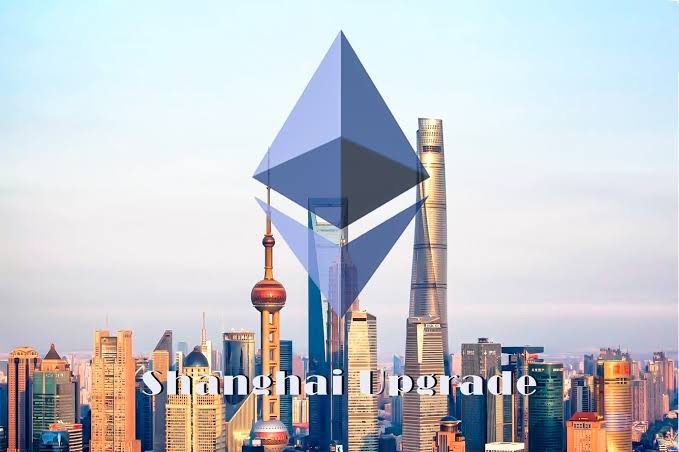The successful Shanghai Ethereum upgrade makes it possible for users to withdraw ETH staked on the Beacon Chain. Not only does this fuel strong ETH staking activity, but it also has a significant impact on the Liquid staking derivatives (LSD) market. What is the reason?
Shanghai upgrade successfully

Ethereum successfully performed the Shanghai upgrade at 5:00 am on April 13, 2023. The update went as planned, users could unstake ETH, but not all ETH will be unlocked simultaneously, but this number is limited to the amount per day.
According to information from Ethereum, users will have two options to withdraw ETH:
- Partial withdrawals: Users only withdraw the staking interest received since the launch of the ETH staking function, still retaining the minimum amount of ETH to operate a validator node (32 ETH). Partial withdrawals will be faster than full withdrawals. About 155,000 validators are withdrawing ETH every day, so it will take about 4-5 days for all validators which want to withdraw a part of it.
- Full withdrawals: Users withdraw all the initial ETH and interest received from the staking pool. When withdrawing, that validator will be marked as “exited” and terminate the operation of a validator node after completing ETH withdrawal. Full withdrawals are limited to 8 exits per epoch or 1800 exits per day or approximately 1800 x 32 = 57,600 ETH (worth ~110 million USD) estimated to be withdrawn per day. With ~530,000 validators at the moment, it takes about 516 days for all validators to withdraw ETH provided no additional users stake.
In order to withdraw ETH, users need to update their credentials to 0x01 instead of 0x00 as initially, and the validator cannot change the withdrawal address after updating the credentials.
Liquid staking derivatives (LSD) are a good choice
According to data from Nansen, out of all validators, only about 67.3% have updated the withdrawal address 0x01, meaning there are 265,972 validators that were unable to perform ETH withdrawals.
Of the ETH waiting to be withdrawn (866,551 ETH), more than 80% are coming from exchanges. Of that, about 63.1% came from Kraken. This is because the US Securities and Exchange Commission (SEC) pressured and forced the exchange to withdraw all the ETH staked. Another exchange that also faces a similar situation is Coinbase (10.8%), both of which are likely to have to stop the ETH staking service due to pressure from the SEC.
It is considering the total amount of ETH that has been withdrawn since Shanghai succeeded. More than 56.1% have been from Lido’s wallet address. This is because Lido allows stakers to withdraw ETH faster under all conditions by using the Lido protocol buffer to get priority when making withdrawal requests.
The level of ETH withdrawal is likely to remain the same for the next 5 days (estimated time for users to complete a partial withdrawal). It is likely that this number will gradually decrease due to only full withdrawals, Not to mention users can stake more ETH. The market can absorb this withdrawn ETH volume if nothing changes suddenly.
Liquid staking derivatives (LSD) problems solved
Reduced risk of losing peg
Once the ETH withdrawal mechanism is enabled, users can withdraw ETH via liquid staked ETH (stETH,cbETH…), which further ensures liquidity and keeps the peg for these tokens, while minimizing risk for stakers. Previously, the pegs of these tokens were unstable due to the impact of events related to Three Arrow Capital, Celsius & Alameda Research.
As soon as the upgrade is complete, the price of stETH has almost returned to the 1:1 peg against ETH. The cbETH/ETH rate even increased slightly to 1.03. Users continue to deposit ETH to LSD platforms to stake (94,576 newly staked ETH), TVL of these platforms also increased slightly after Shanghai Upgrade (Lido increased by 5.15%, Rocket Pool increased by 6.22% in 1 day).
Reduce risk at scale
Bets are being risk-free on a massive scale, the age of internet bonds has come, and cryptocurrencies will never be the same again.
Single staking and staking as a service (SaaS) allow crypto participants to generate profits on ETH, but user collateral remains locked and cannot be sold or transferred.
Liquidity staking derivatives (LSDs), including Lido’s stETH and Coinbase’s cbETH, aims to address this liquidity shortage. Currently, the total value of LSD has exceeded US$14.5 billion, and it allows ETH holders to earn income while preserving the liquidity of collateralized ETH.
For many Ethereum users, liquidity staking derivatives have become the de facto method, with LSD accounting for 42% of all ETH liquidity bets.
While LSD improves liquidity, these instruments are often misunderstood as having a 1:1 ratio to ETH, like stablecoins. However, LSD can inherently be less liquid than the underlying ETH collateral.
This vulnerability was on full display during the credit crisis. During the liquidation of Three Arrows Capital and Celsius’s StETH positions starting in May 2022, the price of stETH diverged by 6% over the next month and a half, creating a crisis of confidence among holders to keep LSD. Unable to withdraw funds, these holders can only rely on the promise of an eventual future redemption to maintain a fixed level.
Solving the tax conundrum
Liquidity-collateralized derivatives also pose several tax and regulatory headaches for many professional, institutional investors. Take Lido’s stETH as an example. It is the most commonly used liquid collateral derivative, accounting for 74% of the ETH LSD market, it is a rebase token (rebase mechanism), and every time rebase, it will generate a taxable event for its holder. There are more viable options for tax-conscious investors.
While investors may view ETH as a commodity, this conclusion is only partially agreed upon for some forms of liquidity bets.
Many cryptocurrency exchanges, decentralized protocols, and SaaS providers pool liquid staking returns to provide investors with a steady income. This gives them a security-like quality that the SEC is trying to avoid in its recent settlement with Kraken.
In addition to the regulatory confusion, protocols like Lido and RocketPool have previously chosen and continue incentivizing liquidity on their LSD. It can be argued that these incentives continue to confer security properties on derivatives, as the maintenance of the peg depends in part on the issuance of the token.
Conclusion
Thus, it can be seen that the demand for using LSD platforms after the Shanghai Upgrade will not only not decrease but also increase. This update will likely have a positive impact on promoting ETH staking demand in the long term.
In particular, this trend will focus more on LSD protocols instead of on exchanges. Projects such as Lido, Rocket Pool, Frax, and Stake Wise will likely receive a market share from exchanges when these exchanges cannot continue staking services due to pressure from the SEC.
DISCLAIMER: The Information on this website is provided as general market commentary and does not constitute investment advice. We encourage you to do your own research before investing.
Join us to keep track of news: https://linktr.ee/coincu
Foxy
Coincu News





